14 Best Planner Apps for Android Smartphones
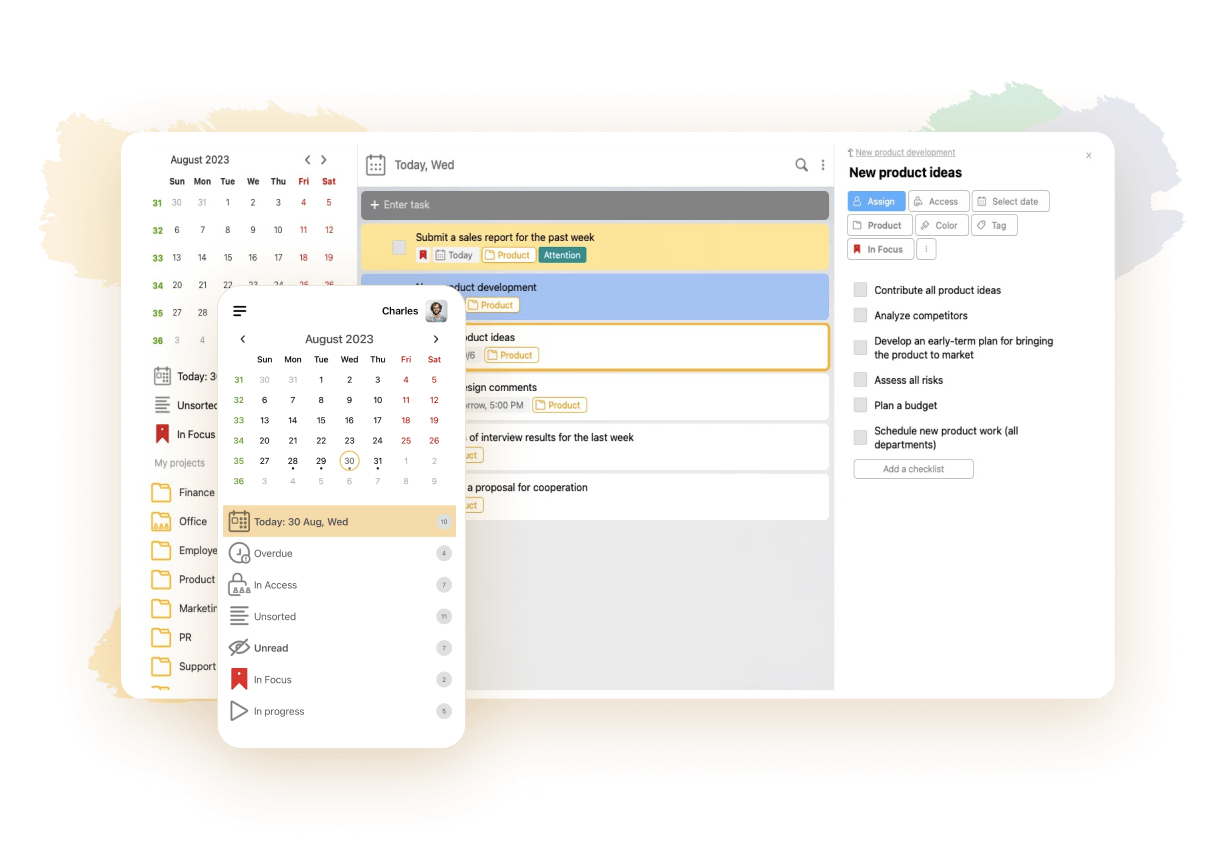
Android planner app can make your life much more organized and enjoyable. You’ll be able to manage your schedule on the go, whenever you have a free minute. Many products have tools to save time for busy people, such as natural language input or the smart suggestions feature. You may want to use such an app to handle your personal routine and your work. Many solutions support collaboration, which means you can grant access to your content to your friends, colleagues and family members. For this review, we hand-picked the best planner apps for Android. We guarantee the superb quality of each item on the list.
Tips on Selecting the Best Planner App for Android
When choosing the best Android planner app, it would be wise to focus on these five vital parameters:
- Ease of managing your schedule on the go. Many planner apps are available in several formats – such as desktop, web and for smartphones. With some products, all the versions are equally decent. With others, web versions might outperform their mobile counterparts – or vice versa.
- Device and platform compatibility. Most solutions can be downloaded on any Android phone – but there are exceptions that are compatible exclusively with selected brands. Many products have versions for alternative operating systems, such as Windows, macOS or iOS – this allows you to sync data across multiple devices.
- UX/UI. Some apps boast a modern and minimalistic design while others mimic the aesthetics of oldschool paper planners. Some apps allow you to flexibly customize their interfaces while others don’t.
- Functionality. A most basic planner lets you schedule your routine day by day and set reminders for your events. Its more advanced counterparts allow you to attach files to your notes, share your content with others, work with a team, track your productivity, add new content with the help of a stylus and perform many other functions.
- Pricing. It’s rather realistic to get a top-notch solution for less than $5 per month. If the app charges you more, make sure it justifies its price tag with its competitive edge. Plus, never miss your chance to start with a free plan or free trial.
Let’s have a look at the top solutions that enjoy a steady demand among Android users.
1. LeaderTask
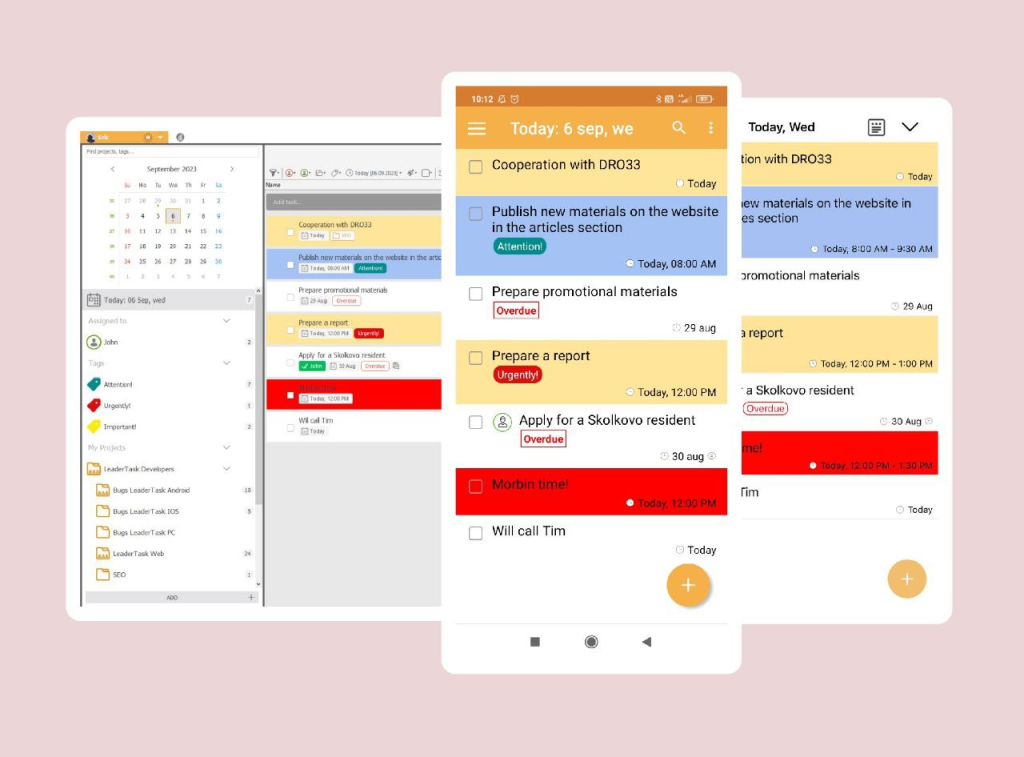
💌 Score out of five: 4.8
👍 What’s unique about it: Full-fledged offline mode
👎 What leaves to be desired: Opportunity to print out your schedule is available only in the Windows version of the app
🏳️ Entry-level monthly plan: $3.33
To our mind, it’s the best planner for Android. At an affordable price, you get access to a multitude of features that enable you to schedule and optimize every aspect of your life. The process of adding and editing tasks is extremely intuitive. You can switch between multiple viewing formats and benefit from a time scale in the daily one – it lets you arrange your to-dos in any sequence. You’ll be able to fine-tune the app so that it displays your activities only for a specific time frame – such as only four hours per day that you devote to work being a part-time contributor.
LeaderTask allows you to print out your plans for the desired period. Unfortunately, this option is currently relevant only for the Windows version of the app but not its Android counterpart.
Apart from the planner, LeaderTask can double as your calendar app with notifications, a productivity tracker, a task collaboration platform and a project management tool. It’s powerful and versatile and its learning curve is deliciously shallow. You’ll be able to work with it even when offline.
2. Todoist

💌 Score out of five: 4.7
👍 What’s unique about it: Natural language input
👎 What leaves to be desired: Limited viewing formats
🏳️ Entry-level monthly plan: $4
In this app, you can create tasks, split them into smaller ones and merge them into lists and projects. The approach to prioritizing your schedule items is top-notch, so you’ll never be late with your most urgent to-dos. The interface is remarkably user-friendly and you’ll be able to give commands to the app with plain language. Todoist is perfect for teams because it allows you to share tasks with others and collaborate on them. Handy notifications will ensure everyone remembers their deadlines and goals. This product integrates with various third-party ones and you’ll be able to access it from different platforms.
Unfortunately, Todoist fails to offer as many viewing formats as some of its competitors.
3. Notion
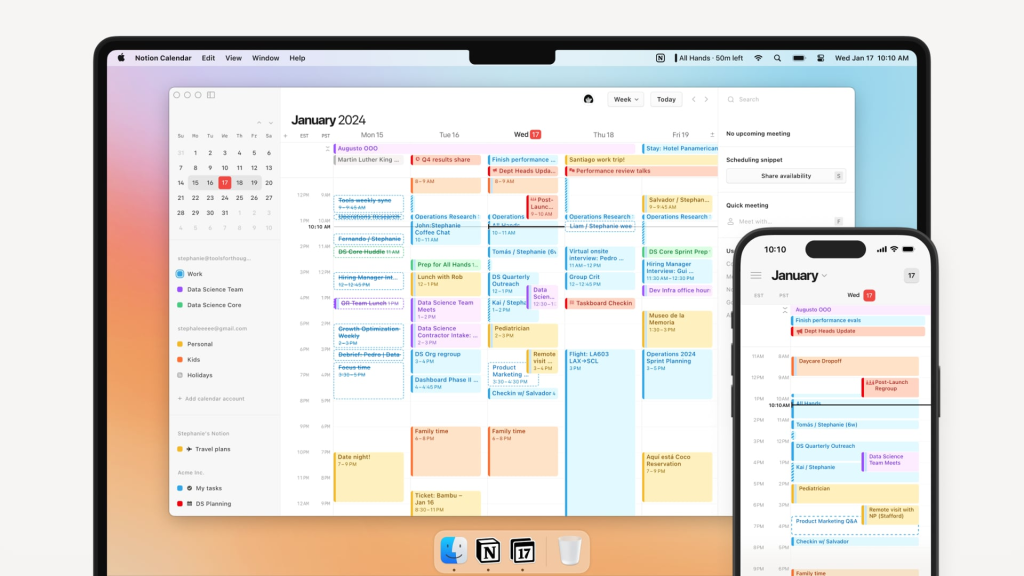
💌 Score out of five: 4.7
👍 What’s unique about it: Excellent visual representation of your workload
👎 What leaves to be desired: Customization can seem overwhelming for some users
🏳️ Entry-level monthly plan: $8
This tool comes in handy not only for individual planning but also for organizing the workflows of a team. It enables you to take notes, handle databases and work with spreadsheets. In addition to the traditional calendar view, there is a Kanban one – the latter is indispensable for complex projects whose members want their workload to be displayed as visually comprehensive as possible. Notion effortlessly adapts to various planning styles and lets you track your progress. You’ll be able to work with it even offline.
As for the shortcomings, some users get confused over a too large number of templates, formats and settings to choose from.
4. Trello
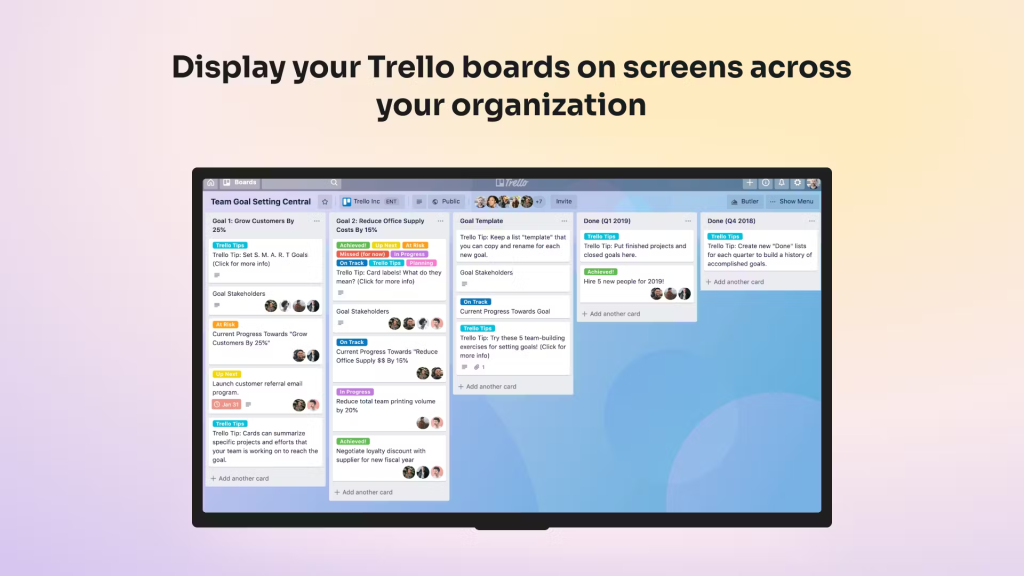
💌 Score out of five: 4.6
👍 What’s unique about it: Superb digital analog of sticky cards that people used to attach to the walls
👎 What leaves to be desired: No task dependencies
🏳️ Entry-level monthly plan: $5
Before digital planners became commonplace, people would attach sticky paper notes to their mood boards, fridges and mirrors. Apart from its multiple drawbacks, that system had an awesome advantage: it was visually intuitive to the maximum possible extent. The Trello developers found a way to transfer this method into an app. You’ll find yourself on a board where you can create and edit cards with tasks, set due dates for them, break them down into smaller ones, arrange them into lists and customize them with outstanding flexibility. To categorize your content, feel free to rely on labels and filters. It will be convenient for you to deal with both tasks and projects. This app has worthy collaboration tools and is suitable for business purposes.
In spite of being highly functional, Trello fails to display task dependencies.
5. nTask
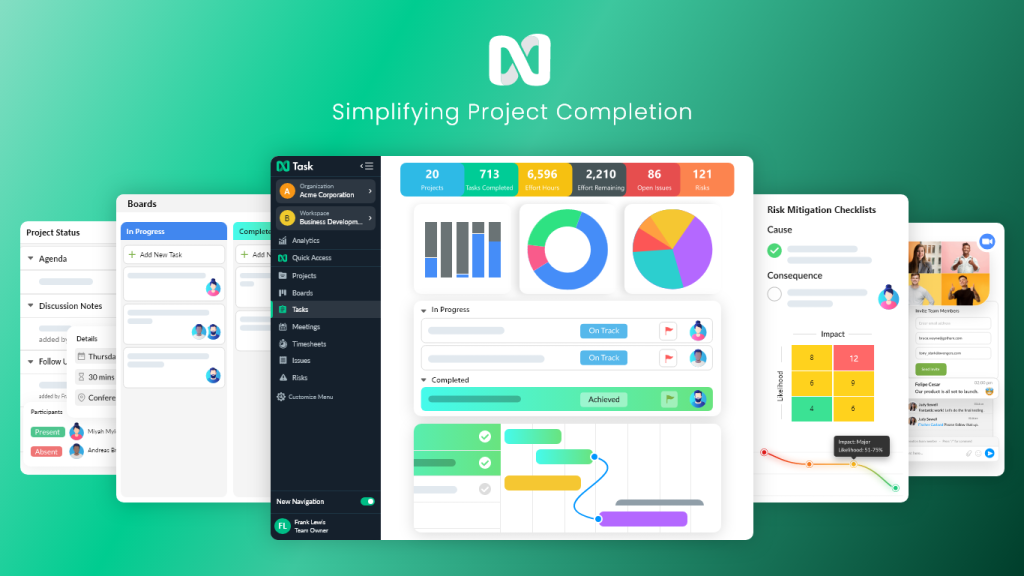
💌 Score out of five: 4.6
👍 What’s unique about it: Risk management instrument
👎 What leaves to be desired: Steep learning curve for some users
🏳️ Entry-level monthly plan: $3
You can use nTask as your personal diary. But it’s the sphere of professional planning where this app genuinely shines. It lets you create, prioritize and edit tasks. You’ll be able to merge your to-dos into projects, distribute tasks among your team members, set milestones for each of them and collaborate on assignments. Gantt charts can significantly facilitate your workflows by representing task dependencies and timelines in a visually comprehensive manner. The biggest gem of this app is its risk management instrument. It lets you identify potential pitfalls and comes up with recommendations on avoiding them.
nTask deserves some criticism for its learning curve which can seem steep for users who have limited experience in handling this type of software.
6. Google Calendar

💌 Score out of five: 4.6
👍 What’s unique about it: It’s part of the Google ecosystem
👎 What leaves to be desired: Limited integrations
🏳️ Entry-level monthly plan: No paid plans
This one can be your natural choice if you regularly use other Google products. You’ll benefit from the synergy effect within the ecosystem. If you prefer other solutions, you might be not too happy with the limited integrations of this app. As for the devices, it sync effortlessly with many different computers, laptops, tablets and smartphones.
Its interface is extremely intuitive. There are different viewing formats to choose from. You can flexibly customize the types of tasks and events as well as the notifications and reminders for them. The app supports multiple time zones, which is great for frequent travelers and members of distributed teams.
7. Evernote
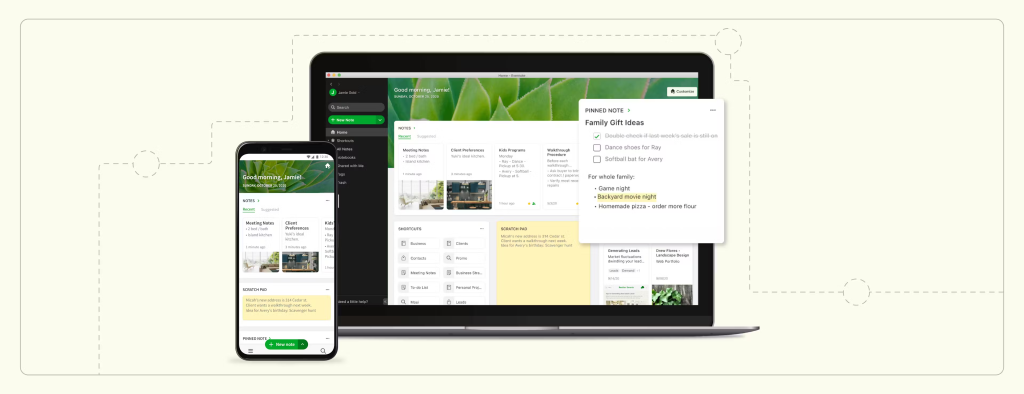
💌 Score out of five: 4.5
👍 What’s unique about it: Web-clipping feature
👎 What leaves to be desired: Storage limitations in the free version
🏳️ Entry-level monthly plan: $10.83
As its name suggests, this product was originally conceived for taking notes. It’s good for capturing your ideas on the go, composing to-do lists and organizing miscellaneous data. You’ll appreciate the hierarchical structure, task checkboxes and the ability to categorize your schedule items. Evernote stands out from the rest thanks to its compatibility with various platforms and file formats. You’ll be able to attach different types of files to your content, including audio records and images. When browsing web pages, you can clip text and images from them and save them in the app. The accumulated information can come in handy for your mood boards, brainstorms and so on.
On the flip side, the free version of this solution offers limited storage. To make the most of it, be ready to upgrade to a paid plan.
8. ZenDay
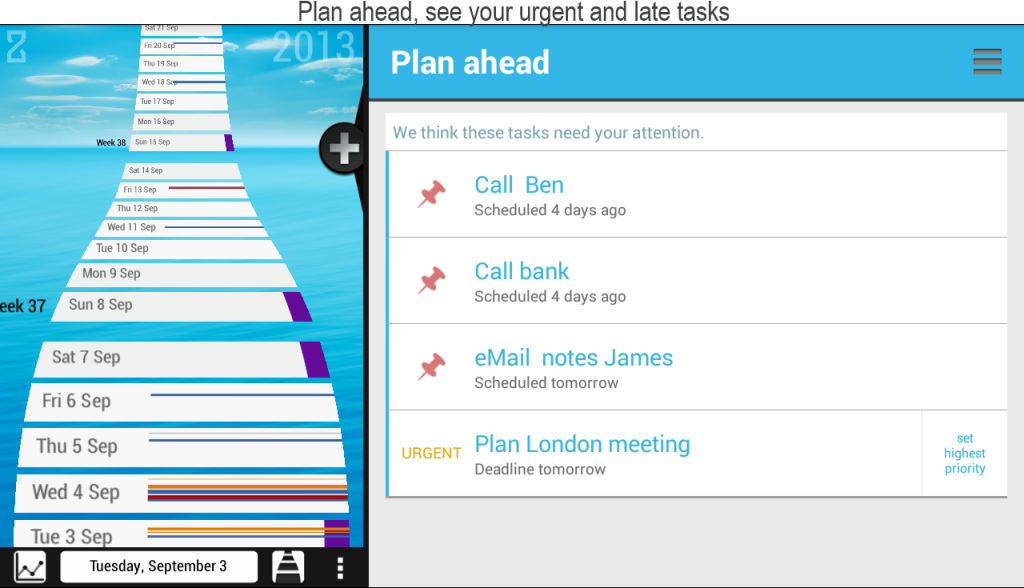
💌 Score out of five: 4.5
👍 What’s unique about it: 3D timeline
👎 What leaves to be desired: Not too suitable for complex business projects
🏳️ Entry-level monthly plan: $10
While most of its competitors offer lists or calendar views, this one boasts a unique 3D timeline for your events and tasks. Such an approach lets you more efficiently handle your deadlines and priorities. To add and manage your content items, you can drag and drop them. Thanks to a gesture-based interface, it’s enough to tap or swipe an element to edit it. Another competitive edge of ZenDay is its smart scheduling algorithms. The longer you use this software, the better it learns your habits and preferences. Based on the accumulated statistics, it can come up with proactive suggestions for improving your time management.
Even though this product can be classified as advanced, it lacks functionality to cope with complex business projects.
9. Remember The Milk

💌 Score out of five: 4.5
👍 What’s unique about it: Location-based reminders
👎 What leaves to be desired: Lack of business-oriented features
🏳️ Annual plan: $49.99
It’s a worthy personal planner with an intuitive interface and a straightforward approach to task management. It has all the basic features necessary to schedule your activities for days, weeks and months ahead. Filters and smart lists are among its coolest tools – they help to organize the multitude of to-dos. Besides, there are excellent location-based reminders that go off only if you’re close to a particular place.
Remember The Milk allows you to share your content with third parties and even delegate tasks to others. But its functionality might fail to satisfy you if you’d like to use it for business.
10. TickTick
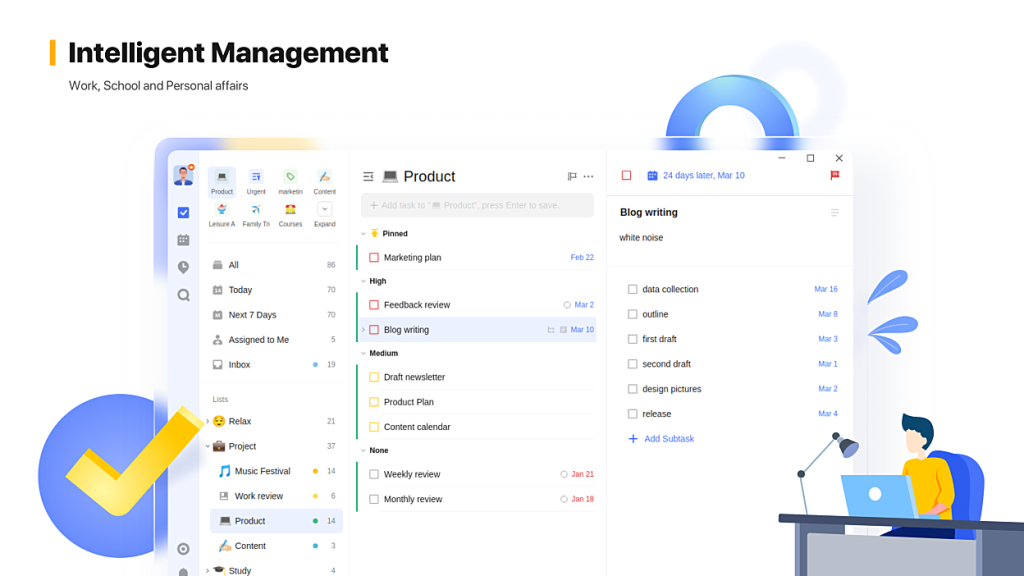
💌 Score out of five: 4.5
👍 What’s unique about it: Ease of use
👎 What leaves to be desired: Limited Kanban view
🏳️ Annual plan: $35.99
This app is easy to use and available across many different platforms. It integrates with multiple third-party calendars. To save time and effort, you can create and edit tasks using everyday speech. You won’t have to push the buttons to prioritize your schedule items as well as set due dates and reminders for them. It will be convenient for you to share your tasks with others and collaborate on them.
As for the shortcomings, TickTick offers a Kanban view – but compared to alternatives, it’s not too powerful and user-friendly.
11. Planner Pro

💌 Score out of five: 4.4
👍 What’s unique about it: Cool time-blocking feature
👎 What leaves to be desired: Lack of a subscription
🏳️ Entry-level monthly plan: No paid plan – but there are in-app purchases
This app contains three modules: calendars, tasks and notes. The first module supports three viewing formats: daily, weekly and monthly. The second one enables you to merge your tasks into projects as well as categorize them by several parameters. As for the notes, things are rather obvious. Even though the name of this app features the Pro element, it’s incredibly intuitive and perfect for the entry-level audience. Its users praise its time-blocking feature, powerful search functions and the ease of breaking tasks into subtasks.
On the flip side, the in-app purchases in Planner Pro might cost you more than the monthly subscriptions of some of its competitors.
12. Artful Agenda
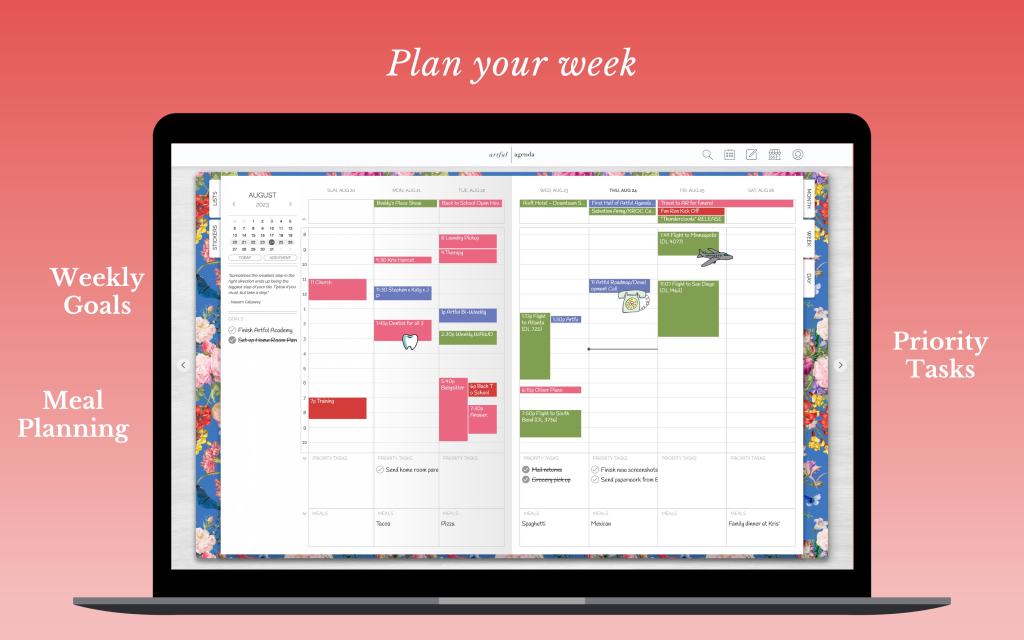
💌 Score out of five: 4.4
👍 What’s unique about it: Aesthetics of an oldschool paper organizer
👎 What leaves to be desired: Lack of robust task management tools
🏳️ Annual plan: $44.99
This one mimics the aesthetics of a regular paper organizer. It lets you switch between multiple viewing formats, take notes, add time slots for to-dos, block time, use stickers and benefit from premium covers. You’ll be able to compose to-do lists, share your calendar with others and sync your content across some of the most popular third-party solutions. As a cherry on top, this app is compatible with various styluses and e-pens.
Artful Agenda can be spot-on for managing your personal daily agenda. However, it lacks robust features to handle complex projects.
13. GoodNotes
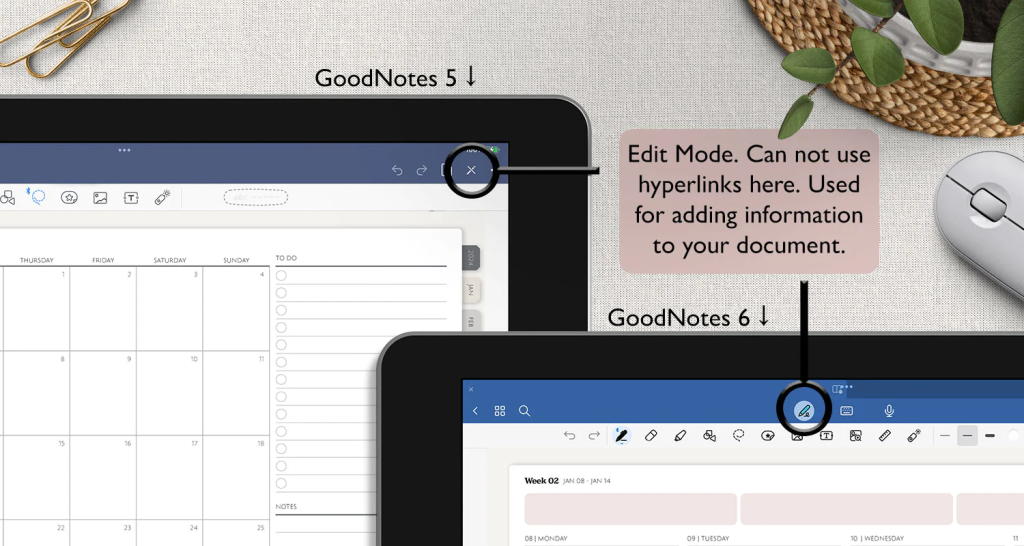
💌 Score out of five: 4.4
👍 What’s unique about it: Opportunity to scribble down notes and make sketches with a stylus
👎 What leaves to be desired: Focus on note-taking
🏳️ Entry-level monthly plan: $6.99
Just like the previous one, it sticks to the pre-digital visual aesthetics. This simple app was originally designed for taking notes – but nothing prevents you from planning your routine in it. You can either type in your content or put it down with a stylus. GoodNotes can recognize your handwriting and it allows you to make sketches on the display. Your drawing as well as digital stickers can come in handy for personalizing your schedule.
If you prefer digital stylistics, feel free to choose from handy templates and try the PDF markup. There are templates for different audience segments, such as for students or individuals who stick to a nutrition regime. Many templates are compatible with third-party calendars. You’ll be able to sync your data with a cloud and user folders to store it in a well-organized manner.
As for the drawbacks, this product fails to offer robust functionality for collaborative work or complex business projects.
14. Samsung Notes
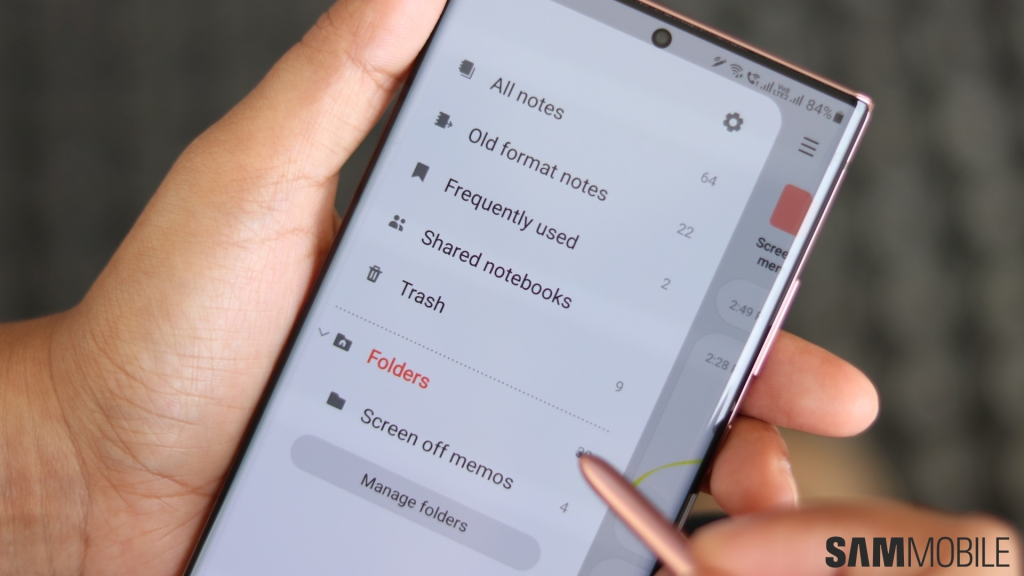
💌 Score out of five: 4.3
👍 What’s unique about it: Handwriting recognition
👎 What leaves to be desired: Compatibility only with Samsung gadgets
🏳️ Entry-level monthly plan: No paid plan
If you have a Samsung phone, try this application. It enables you to sync your data across multiple devices by the same manufacturer. Moreover, it’s compatible with the S Pen – which means you can scribble down your content as on a piece of paper instead of typing it in. You’ll be able to add reminders to your to-dos, record audio files and save your schedule in a cloud. On the flip side, this solution lacks advanced functionality for managing your business activities and fails to integrate with third-party products.
Final Thoughts
Planner apps for Android are available in many different variations: for private or professional use and with basic or advanced functionality. LeaderTask boasts an optimal combination of all the meaningful factors. Consider trying its free version!



